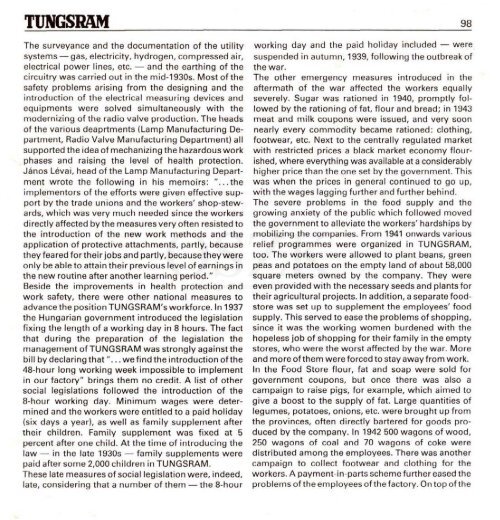THE HISTORY OF TUNGSRAM 1896-1945 - MEK
THE HISTORY OF TUNGSRAM 1896-1945 - MEK
THE HISTORY OF TUNGSRAM 1896-1945 - MEK
- No tags were found...
You also want an ePaper? Increase the reach of your titles
YUMPU automatically turns print PDFs into web optimized ePapers that Google loves.
<strong>TUNGSRAM</strong> 98The surveyance and the documentation of the utilitysystems — gas, electricity, hydrogen, compressed air,electrical power lines, etc. — and the earthing of thecircuitry was carried out in the mid-1930s. Most of thesafety problems arising from the designing and theintroduction of the electrical measuring devices andequipments were solved simultaneously with themodernizing of the radio valve production. The headsof the various deaprtments (Lamp Manufacturing Department,Radio Valve Manufacturing Department) allsupported the idea of mechanizing the hazardous workphases and raising the level of health protection.Janos Levai, head of the Lamp Manufacturing Departmentwrote the following in his memoirs: "...theimplementors of the efforts were given effective supportby the trade unions and the workers' shop-stewards,which was very much needed since the workersdirectly affected bythe measures very often resisted tothe introduction of the new work methods and theapplication of protective attachments, partly, becausethey feared fortheir jobs and partly, because they wereonly be able to attain their previous level of earnings inthe new routine after another learning period."Beside the improvements in health protection andwork safety, there were other national measures toadvance the position <strong>TUNGSRAM</strong>'S workforce. In 1937the Hungarian government introduced the legislationfixing the length of a working day in 8 hours. The factthat during the preparation of the legislation themanagement of <strong>TUNGSRAM</strong> was strongly against thebill by declaring that ".. .we find the introduction of the48-hour long working week impossible to implementin our factory" brings them no credit. A list of othersocial legislations followed the introduction of the8-hour working day. Minimum wages were determinedand the workers were entitled to a paid holiday(six days a year), as well as family supplement aftertheir children. Family supplement was fixed at 5percent after one child. At the time of introducing thelaw — in the late 1930s — family supplements werepaid after some 2,000 children in <strong>TUNGSRAM</strong>.These late measures of social legislation were, indeed,late, considering that a number of them — the 8-hourworking day and the paid holiday included — weresuspended in autumn, 1939, following the outbreak ofthe war.The other emergency measures introduced in theaftermath of the war affected the workers equallyseverely. Sugar was rationed in 1940, promptly followedby the rationing of fat, flour and bread; in 1943meat and milk coupons were issued, and very soonnearly every commodity became rationed: clothing,footwear, etc. Next to the centrally regulated marketwith restricted prices a black market economy flourished,where everything was available at a considerablyhigher price than the one set by the government. Thiswas when the prices in general continued to go up,with the wages lagging further and further behind.The severe problems in the food supply and thegrowing anxiety of the public which followed movedthe government to alleviate the workers' hardships bymobilizing the companies. From 1941 onwards variousrelief programmes were organized in <strong>TUNGSRAM</strong>,too. The workers were allowed to plant beans, greenpeas and potatoes on the empty land of about 58,000square meters owned by the company. They wereeven provided with the necessary seeds and plants fortheir agricultural projects. In addition, a separate foodstorewas set up to supplement the employees' foodsupply. This served to ease the problems of shopping,since it was the working women burdened with thehopeless job of shopping for their family in the emptystores, who were the worst affected by the war. Moreand more of them were forced to stay away from work.In the Food Store flour, fat and soap were sold forgovernment coupons, but once there was also acampaign to raise pigs, for example, which aimed togive a boost to the supply of fat. Large quantities oflegumes, potatoes, onions, etc. were brought up fromthe provinces, often directly bartered for goods producedby the company. In 1942 500 wagons of wood,250 wagons of coal and 70 wagons of coke weredistributed among the employees. There was anothercampaign to collect footwear and clothing for theworkers. A payment-in-parts scheme further eased theproblems of the employees of the factory. On top of the








![Letöltés egy fájlban [4.3 MB - PDF]](https://img.yumpu.com/50159926/1/180x260/letaltacs-egy-fajlban-43-mb-pdf.jpg?quality=85)







